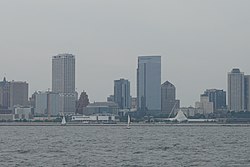Downtown Milwaukee | |
|---|---|
Central business district and residential area | |
 Downtown Milwaukee's skyline, as seen from Lake Michigan in July 2022 | |
 | |
| Coordinates: 43°02′30″N 87°54′40″W / 43.04167°N 87.91111°W | |
| Country | |
| State | |
| Government | |
| • Type | Milwaukee Common Council |
| • Alderman | Robert Bauman |
| Area | |
| • Total | 2.51 sq mi (6.5 km2) |
| Elevation | 617 ft (188 m) |
| Population | |
| • Total | 26,710 |
| • Density | 10,641/sq mi (4,109/km2) |
| Time zone | UTC-6 (EST) |
| • Summer (DST) | UTC-5 (EDT) |
| ZIP code(s) | 53202, 53203 |
| Area code | 414 |
| Website | https://www.milwaukeedowntown.com/ |
Downtown Milwaukee is the central business district of Milwaukee, Wisconsin.[2] The economic and symbolic center of the city and the Milwaukee metropolitan area, it is Milwaukee's oldest district and home to many of region's cultural, financial educational and historical landmarks including Milwaukee City Hall, Fiserv Forum and the Milwaukee Art Museum. The city's modern history began in Downtown Milwaukee in 1795 when fur trader Jacques Vieau (1757–1852) built a post along a bluff on the east side, overlooking the Milwaukee and Menomonee rivers.[3]
Downtown is bounded by Lake Michigan to the east, Interstate 43 to the west, East Brady Street Historic District to the north, and the three rivers of the confluence to the south, (Milwaukee River, Menomonee River, Kinnickinnic River). It encompasses several subdistricts, and its diverse architecture includes the Milwaukee City Hall, which was once the tallest City Hall in the world when completed in 1895.[4] Downtown Milwaukee's residential population has grown significantly since the 2000s and especially 2010s, registering the largest population growth, by percentage, of any Milwaukee neighborhood over that time.[5]
- ^ "USA: Milwaukee - Racine - Waukesha CSA". City Population. Thomas Brinkhoff. Retrieved 11 July 2022.
- ^ "Attractions". Milwaukee Downtown. Retrieved October 13, 2020.
- ^ "A Brief History of Milwaukee". Wisconsin Historical Society. 24 July 2012. Archived from the original on Sep 22, 2023.
- ^ "Basic Facts About City Hall". City of Milwaukee. Archived from the original on Sep 29, 2023.
- ^ Thomas, Arthur (26 September 2021). "Public record: Where is Milwaukee County growing?". BizTimes. Archived from the original on Nov 30, 2022.